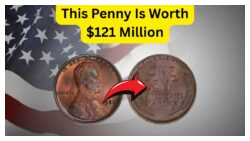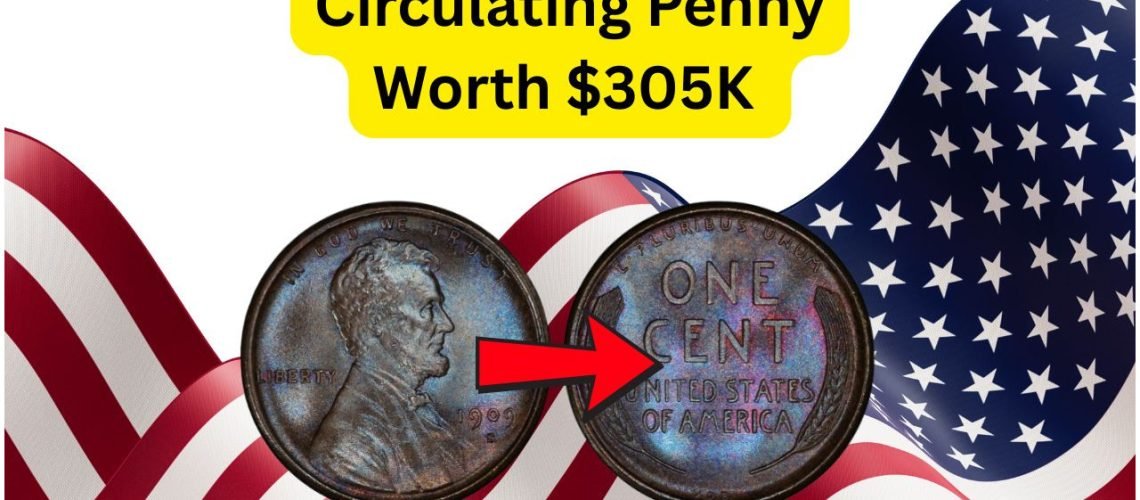Lincoln Wheat Penny
Table of Contents
Toggle
Discovering the Lincoln Wheat Penny Worth $305K
Lincoln Wheat Penny: The world of numismatics is filled with fascinating tales of rare coins that hold tremendous value, both historically and monetarily. One such coin that continues to capture the interest of collectors and enthusiasts alike is the Lincoln Wheat Penny. This seemingly ordinary coin, still found in circulation today, can be worth a staggering $305,000, making it a highly sought-after artifact among coin collectors.
- First minted in 1909, the Lincoln Wheat Penny was designed by Victor D. Brenner.
- The coin features the iconic profile of President Abraham Lincoln on the obverse side.
- Its reverse showcases two wheat ears, a design that persisted until 1958.
- Collectors particularly prize the 1943 copper variant due to its rarity.
- Most Lincoln Wheat Pennies are made of bronze except during World War II when steel was used.
- The 1943 copper penny is the star of this series, fetching the highest prices at auctions.
The Allure of the Lincoln Wheat Penny
The allure of the Lincoln Wheat Penny lies in its historical significance and the stories that each penny carries. As one of the first coins to feature a real person, it marked a shift in American numismatic design. This penny was introduced to commemorate the centennial of Abraham Lincoln’s birth, making it a piece of history in your pocket. The rarity of certain editions, like the 1943 copper penny, adds an element of mystery and excitement for collectors. Legend has it that only a few dozen of these copper pennies were mistakenly minted, as the U.S. Mint had switched to steel to conserve copper for the war effort. The scarcity and accidental creation of these pennies fuel their high value, with one selling for $305,000 at auction.
| Year | Material | Mint Mark | Rarity | Value | Notable Sales | Condition | Features |
|---|---|---|---|---|---|---|---|
| 1909 | Bronze | S | Rare | $1,200+ | High | Mint | With “VDB” initials |
| 1914 | Bronze | D | Rare | $150+ | Moderate | Good | Low mintage |
| 1922 | Bronze | No D | Very Rare | $2,000+ | High | Fine | Missing mint mark |
| 1943 | Copper | D | Extremely Rare | $305,000 | Record | Excellent | War-time error |
| 1955 | Bronze | – | Moderate | $1,000+ | High | Good | Double die |
| 1958 | Bronze | P | Common | $50+ | Moderate | Very Fine | Last wheat design |
| 1969 | Bronze | S | Rare | $35,000+ | High | Uncirculated | Double die |
The Journey of a Lincoln Wheat Penny
The journey of a Lincoln Wheat Penny from minting to the present day is a tale of survival and luck. Many of these pennies have been lost or worn down through years of circulation, making the discovery of a well-preserved coin a rare event. Enthusiasts often search through old rolls of pennies or estate sales, hoping to find one of these gems. The chance to find a 1943 copper penny, the crown jewel of the collection, adds a layer of intrigue. Collectors often share stories of their discoveries, from stumbling upon a rare penny in a relative’s change jar to purchasing a roll of pennies at a yard sale and finding an unexpected treasure.

Is the Lincoln Wheat Penny Worth $121 Million Still Circulating?
- Many collectors start their journey by searching through penny rolls from banks.
- Estate sales and auctions are popular avenues for finding rare pennies.
- Some enthusiasts purchase metal detectors to aid their search.
- Online marketplaces also serve as a resource for collectors.
- Joining a coin club can provide valuable connections and knowledge.
How to Identify a Valuable Lincoln Wheat Penny
Identifying a valuable Lincoln Wheat Penny requires a keen eye and some numismatic knowledge. Key factors that determine a penny’s value include its date, mint mark, material, and condition. For instance, a 1943 penny made of copper instead of the wartime standard steel is highly prized. Furthermore, certain mint marks like the “D” for Denver or “S” for San Francisco can also increase a penny’s value. Condition plays a crucial role, as uncirculated coins or those in mint condition fetch higher prices. Collectors often use magnifying glasses to inspect the details of a penny, checking for abnormalities like double dies or missing mint marks.
| Feature | Importance | Indication of Value | Example |
|---|---|---|---|
| Date | High | Older dates often more valuable | 1909, 1914, 1943 |
| Mint Mark | Moderate | Some marks are rarer | S, D, No D |
| Material | High | Different materials indicate errors | 1943 Copper |
| Condition | High | Better condition increases value | Uncirculated |
Preserving Your Lincoln Wheat Penny Collection
Preserving your collection of Lincoln Wheat Pennies is essential to maintaining their value over time. Proper storage methods help prevent damage and deterioration. One popular method is using acid-free coin holders or flips to protect coins from environmental factors. It’s crucial to store coins in a cool, dry place to avoid oxidation, which can tarnish the surface. Collectors should handle coins with clean hands or gloves to prevent oils from causing damage. Regularly inspecting coins for signs of wear or damage allows for timely interventions, ensuring that your collection remains in pristine condition. Additionally, documenting the provenance and details of each coin can enhance its historical value.
- Store coins in acid-free holders or albums.
- Avoid direct sunlight to prevent fading.
- Use gloves when handling to avoid fingerprints.
- Keep coins in a stable, cool environment.
- Document each coin’s details and history.
- Regularly check coins for signs of corrosion.
Trading and Selling Lincoln Wheat Pennies
The market for trading and selling Lincoln Wheat Pennies is vibrant and dynamic, with collectors eager to acquire rare pieces to complete their collections. Understanding market trends and the interests of potential buyers can significantly impact the success of a sale. Auctions, both online and in-person, often present the best opportunities for selling high-value pennies. Websites dedicated to numismatics provide platforms for listing coins, reaching a broad audience of collectors. Networking with other enthusiasts and joining coin clubs can also facilitate trades and sales. Pricing a penny appropriately involves researching recent sales and considering the coin’s rarity, condition, and demand.

Could This Lincoln Wheat Penny in Circulation Be Worth $3,172,500?
- Participate in numismatic auctions for high visibility.
- List valuable coins on specialized websites.
- Engage with collector communities for networking.
- Research market trends before pricing your coins.
- Consider professional appraisal for rare coins.
Frequently Asked Questions About Lincoln Wheat Pennies
- What makes the 1943 Lincoln Wheat Penny so valuable? Rare copper material due to a minting error makes it highly sought after.
- How can I determine the value of my Lincoln Wheat Penny? Consider the date, mint mark, material, and condition, and consult recent sales.
- Where is the best place to sell rare Lincoln Wheat Pennies? Online auctions and numismatic websites offer the best platforms for selling.
- Are Lincoln Wheat Pennies still being found in circulation? Yes, though rare, they can occasionally be found in circulation or collections.
- What should I do if I find a rare Lincoln Wheat Penny? Preserve it carefully and consider having it appraised by a professional.
Exploring the Numismatic World
Lincoln Wheat Penny
Lincoln Wheat Penny
Lincoln Wheat Penny
Lincoln Wheat Penny
Lincoln Wheat Penny
Disclaimer: This article is written for general informational purposes only. Please get the latest and accurate information from the official website.










